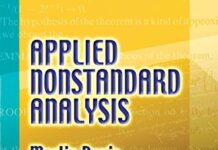
Ebook Info
- Published: 2013
- Number of pages: 128 pages
- Format: PDF
- File Size: 2.74 MB
- Authors: Martin Davis
Description
This introduction to functional analysis is based on the lecture notes of Martin Davis, a distinguished professor of mathematics. The treatment demonstrates the essential unity of mathematics without assuming more background than can be expected of advanced undergraduates and graduate students majoring in mathematics.A self-contained exposition of Gelfand’s proof of Wiener’s theorem, this volume explores set theoretic preliminaries, normed linear spaces and algebras, functions on Banach spaces, homomorphisms on normed linear spaces, and analytic functions into a Banach space. Numerous problems appear throughout the book.
User’s Reviews
Reviews from Amazon users which were colected at the time this book was published on the website:
⭐Martin Davis states clearly in the preface to his “First Course in Functional Analysis” that his intention was to give a treatment from scratch of Gelfand’s beautiful proof, using maximal ideals, of Wiener’s classical result on the existence of an absolutely convergent trigonometric series expansion for the reciprocal of a non-vanishing function which is itself the sum of an absolutely convergent trigonometric series. I must say that he does a remarkable job of it. He builds up the necessary machinery, and only that which is necessary, to accomplish the task, right from basic set theory to very elementary analysis, point-set topology and abstract algebra. The book is truly self-contained (it, of course, requires the usual “mathematical maturity”), but, as usual, only those who already have some experience with the subject matter will truly appreciate it.The title of the book is actually a misnomer. Any “first course” in Functional Analysis spends enough time on the three pillars, after the Hahn-Banach Theorem, of the subject: the Open Mapping and Closed Graph Theorems and the Uniform Boundedness Principle. Other must-haves are the weak and weak* topologies (particularly the Banach-Alaoglu Theorem) and basic Hilbert Space theory (upto the Spectral Theorem). None of these find any mention in Davis’s book. After all, they aren’t needed to present Gelfand’s proof. This is precisely what I found refreshing about Davis’s book. It wasn’t intended to be an introductory course on the subject, developing machinery and ideas which could, and would, be used in subsequent higher-level courses. It had a definite, clear-cut objective. It wanted to present a famous and deep non-trivial result, and it wanted to do so in an aesthetic way. (Wiener’s original proof is supposedly longer and harder.)Davis does spend time on Zorn’s Lemma and the interesting digression of the functional equation f(x) + f(y) = f(x + y). He gives existence proofs for the solutions of Volterra and Fredholm integral equations. To prove the Gelfand-Mazur Theorem (not named in the book; labelled simply as a theorem), he treats of the basics of Banach Space-valued analytic functions. The most taxing part of the book is his presentation of Peter Lax’s proof, which uses the Hahn-Banach Theorem, on the existence of a Green function for an arbitrary Cauchy domain.The book does have more than its justified share of typographical errors, which are always a nuisance in a mathematics book. There are also a few errors involving summation indices. Aside from these, however, the book is eminently readable and highly recommended.
⭐
⭐
Keywords
Free Download A First Course in Functional Analysis (Dover Books on Mathematics) in PDF format
A First Course in Functional Analysis (Dover Books on Mathematics) PDF Free Download
Download A First Course in Functional Analysis (Dover Books on Mathematics) 2013 PDF Free
A First Course in Functional Analysis (Dover Books on Mathematics) 2013 PDF Free Download
Download A First Course in Functional Analysis (Dover Books on Mathematics) PDF
Free Download Ebook A First Course in Functional Analysis (Dover Books on Mathematics)





